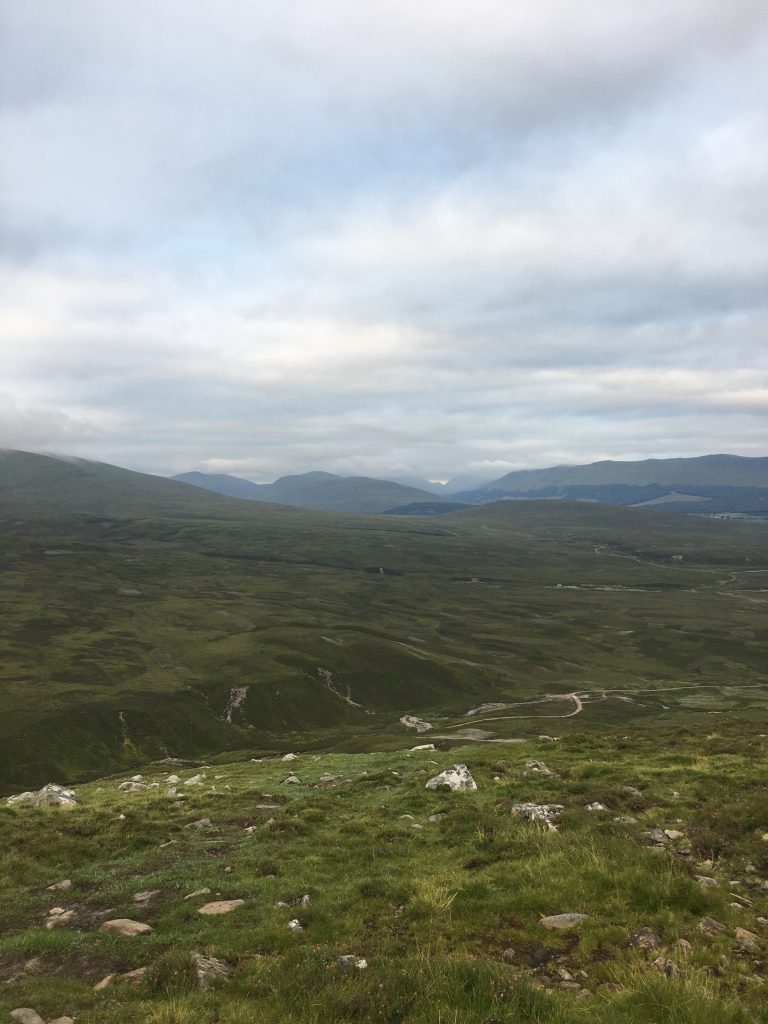
When I first started visiting higher places, I used to look back at views like this and think of adjectives like rugged, wild, untouched, natural. Over the years, I now look at it differently. I still love this land but now look at it tinged with sadness and anger for now I see it for the desert that it really is. This is barren, a wasteland, bereft of even the possibility of the life it could have. This is a place that would have so much promise were it not run for profit and greed by its ‘owners’ who pretend to care for it. They are only caring for their own assets and their own future, protecting their own industry and not the wildlife or natural world they encourage you to be responsible for.
The anachronism displayed in certain parts of our ‘wild’ lands in this country is outrageous. We are told to protect nesting birds from dogs because men want to come and shoot the birds later when they are bigger. We are told to stick to a path by people who have clearly taken a vehicle to the very tops of mountains. Every year, around this time, priority is given over massive sections of the country to a handful of individuals to kill deer in the name of sport. And it is your duty to watch out for them.

In my opinion, this is all unacceptable. The whole thing reeks of an attitude from landowners that may accept access laws, but only because they have to. This is an attempt to control this access as much as they can.
The following images are from an information sign in place in the Highlands, kindly produced by Scottish Countryside Alliance Educational Trust, Scottish Land and Estates (Helping Rural Scotland Thrive), Game & Wildlife Conservation Trust Scotland and the Cairngorms National Park Authority. It explains the variety of wildlife you can find on our moors, as well as their justifications for killing some of it. My favourite bit is the passive aggressive tick warning at the end. It’s almost trying to put you off. If you get one, Lyme disease will teach you not to come meddling in these parts.


The justification of the burning of the heather is an absolute crime against nature. It should be as punishable as is the illegal chopping down of trees. As if nature needs any help with its own regeneration. This is burning for business; to maximise grouse numbers so they can be shot later. This is a monoculture, pretend biodiversity. The more I look at the land, the more it sickens me and am thankful that projects such as the Alladale Wilderness Reserve and the Creag Meagaidh National Nature Reserve are on the right track. Pockets of the public, and certainly the internet, are beginning to be convinced also that this is the way forward.
This is a land in stagnation, in a perpetual state of near death. It reminds me of the guy in the bed in the movie Seven. He’s not dead yet. He is dry and degraded, yet a few scant forms of life remain on him. A horrible metaphor, but I remain hopeful that one day we will jump up and let the audience leap out of their seats.

But don’t just take my word for it, ask the Game and Wildlife Conservation Trust about heather burning.
What would happen on heather-dominated heaths?
A: The current landscape of open heathlands dominated by heather is generally perceived as a ‘natural’ environment, whereas in fact it is the product of thousands of years of management by man. Forests were cleared, and vegetation maintained by grazing and burning to produce the heather-dominated landscapes that now exist. If management in these areas were stopped, heather would become old and degenerate and ultimately be lost, bracken would spread, scrub and tree regeneration would gradually occur, and over many decades it would progress to a vegetation community of shrubs, bushes and trees.
‘A community of shrubs, bushes and trees.’ That sounds not bad…
If you’re interested in making this a reality please visit some Rewilding charities and consider supporting them. There are many throughout the world so you can probably find some relevant to your area if you don’t happen to be Scottish.
https://www.johnmuirtrust.org/
https://www.rewildingbritain.org.uk/
https://www.scotlandbigpicture.com/
https://www.healrewilding.org.uk/
Some useful links used during this article.
http://alladale.com/rewilding/
https://www.rewildingbritain.org.uk/rewilding-projects/creag-meagaidh
https://www.ukclimbing.com/articles/opinions/its_time_to_end_burning_on_grouse_moors-13479
https://www.gwct.org.uk/policy/briefings/driven-grouse-shooting/heather-burning/
Live deliberately
Barry
Currently listening to: Primordial Arcana the new Wolves in the Throne Room album of course.




